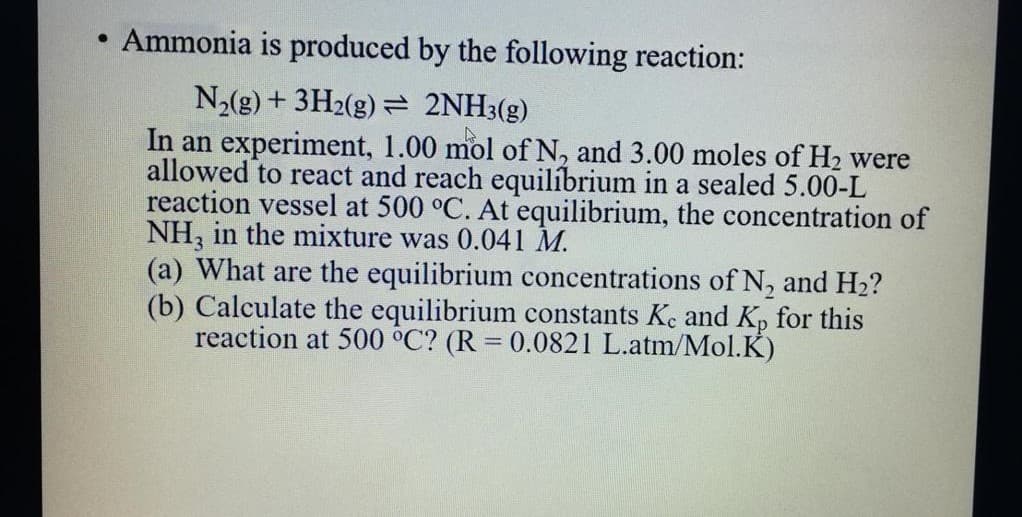Ammonia is produced by the following reaction: N,(g) + 3H2(g) = 2NH3(g) In an experiment, 1.00 mol of N, and 3.00 moles of H2 were allowed to react and reach equilíbrium in a sealed 5.00-L reaction vessel at 500 °C. At equilibrium, the concentration of NH, in the mixture was 0.041 M. (a) What are the equilibrium concentrations of N, and H2? (b) Calculate the equilibrium constants Ke and Kp for this reaction at 500 °C? (R = 0.0821 L.atm/Mol.K) %3D
Ammonia is produced by the following reaction: N,(g) + 3H2(g) = 2NH3(g) In an experiment, 1.00 mol of N, and 3.00 moles of H2 were allowed to react and reach equilíbrium in a sealed 5.00-L reaction vessel at 500 °C. At equilibrium, the concentration of NH, in the mixture was 0.041 M. (a) What are the equilibrium concentrations of N, and H2? (b) Calculate the equilibrium constants Ke and Kp for this reaction at 500 °C? (R = 0.0821 L.atm/Mol.K) %3D
Chemistry & Chemical Reactivity
10th Edition
ISBN:9781337399074
Author:John C. Kotz, Paul M. Treichel, John Townsend, David Treichel
Publisher:John C. Kotz, Paul M. Treichel, John Townsend, David Treichel
Chapter15: Principles Of Chemical Reactivity: Equilibria
Section15.4: Using Equilibrium Constants In Calculations
Problem 15.5CYU: The decomposition of PCl5(g) to form PCl3(g) and Cl2(g) has Kc = 33.3 at a high temperature. If the...
Related questions
Question

Transcribed Image Text:Ammonia is produced by the following reaction:
N,(g) + 3H2(g) = 2NH3(g)
In an experiment, 1.00 mol of N, and 3.00 moles of H2 were
allowed to react and reach equilíbrium in a sealed 5.00-L
reaction vessel at 500 °C. At equilibrium, the concentration of
NH, in the mixture was 0.041 M.
(a) What are the equilibrium concentrations of N, and H2?
(b) Calculate the equilibrium constants Ke and Kp for this
reaction at 500 °C? (R = 0.0821 L.atm/Mol.K)
%3D
Expert Solution
This question has been solved!
Explore an expertly crafted, step-by-step solution for a thorough understanding of key concepts.
This is a popular solution!
Trending now
This is a popular solution!
Step by step
Solved in 2 steps with 2 images

Knowledge Booster
Learn more about
Need a deep-dive on the concept behind this application? Look no further. Learn more about this topic, chemistry and related others by exploring similar questions and additional content below.Recommended textbooks for you

Chemistry & Chemical Reactivity
Chemistry
ISBN:
9781337399074
Author:
John C. Kotz, Paul M. Treichel, John Townsend, David Treichel
Publisher:
Cengage Learning

Chemistry: The Molecular Science
Chemistry
ISBN:
9781285199047
Author:
John W. Moore, Conrad L. Stanitski
Publisher:
Cengage Learning

Principles of Modern Chemistry
Chemistry
ISBN:
9781305079113
Author:
David W. Oxtoby, H. Pat Gillis, Laurie J. Butler
Publisher:
Cengage Learning

Chemistry & Chemical Reactivity
Chemistry
ISBN:
9781337399074
Author:
John C. Kotz, Paul M. Treichel, John Townsend, David Treichel
Publisher:
Cengage Learning

Chemistry: The Molecular Science
Chemistry
ISBN:
9781285199047
Author:
John W. Moore, Conrad L. Stanitski
Publisher:
Cengage Learning

Principles of Modern Chemistry
Chemistry
ISBN:
9781305079113
Author:
David W. Oxtoby, H. Pat Gillis, Laurie J. Butler
Publisher:
Cengage Learning

Chemistry by OpenStax (2015-05-04)
Chemistry
ISBN:
9781938168390
Author:
Klaus Theopold, Richard H Langley, Paul Flowers, William R. Robinson, Mark Blaser
Publisher:
OpenStax


Chemistry
Chemistry
ISBN:
9781305957404
Author:
Steven S. Zumdahl, Susan A. Zumdahl, Donald J. DeCoste
Publisher:
Cengage Learning